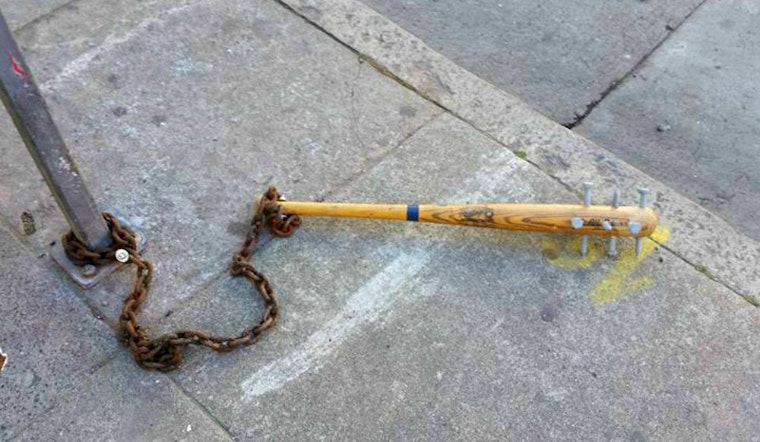
Just after Thanksgiving last year, we noticed something strange: a large number of baseball bats with nails pounded through them had been chained to poles throughout San Francisco. Readers sent in numerous locations where they'd seen the bats, from the Upper Haight to the Marina to Fisherman's Wharf.
SFPD removed all of the bats, saying they could potentially be used as dangerous weapons. But the person or people behind their existence remained a mystery—until now.
Hoodline tracked down the man responsible for creating and installing the bats around San Francisco: 44 of them in all. Artist Matthew Bajda told us that he designed them as a form of artistic expression, to examine the culture of fear in America.

Photo: Nuala Sawyer/Hoodline
Bajda is a familiar face in the San Francisco art scene. He got his start as a graffiti artist, but these days, he works closely with the RVCA Gallery on Haight Street, and as an assistant to local artist Barry McGee.
"I was getting fed up with all of this fear in the media," Bajda told us. "There's a lot of common-sense stuff getting twisted, and it's getting harder for people to sift through what's real and what's contrived."
The 44 bats were his attempt to challenge this media-fed fear. They're intended, he said, to encourage people to question how safe they feel in their own community, and whether this fear is truly warranted. "People shouldn't be so afraid of the world around them," he argued.
Bajda said his choice of wooden bats with spikes through them was intentional, as people have become immune to imagery of guns and knives. The chain was also intentional—the power of a violent weapon is taken away when it's shackled to a pole, he said.
Bajda knew the bats would be controversial. "For a long while, I didn't tell anyone I was doing it, not even the woman I was dating at the time."
He installed them beginning at 4am, intentionally covering a wide swath of San Francisco neighborhoods. The last one was chained to a pole on 19th Avenue at 9:30am on Thanksgiving morning.
The reaction was swift, with witnesses almost immediately documenting their discoveries on Twitter and Instagram. Soon, local and international news media were covering the case, and SFPD quickly got involved. "Since the bats have been altered with spikes, they would be considered a prohibited/deadly weapon, which would be a felony under state law," police spokesman Michael Andraychak told reporters at the time.
Using fingerprints and surveillance video, it didn't take long for SFPD to identify Bajda as the culprit. They stopped by both his house and his workplace, asking for him to come to the station to provide a statement. He refused; the case is technically still open.
He's now decided to come forward to explain the artistic intention behind the bats. "I'd originally just hoped for the best—that people would view the installations how they wanted, or just ignore it," Bajda said. "But once it blew up, I realized it needed an explanation."

Photo: Matthew Bajda
That explanation is coming next week, at an event to be held at new Broderick Street art space The Growlery. There, Bajda will host a panel discussion on the project, titled Mace of Disruption: A Perspective on American Safety. He'll be joined by Matt Gonzalez, the chief attorney of the SF Public Defender's Office; Dan Lawson, a 30-year SFPD veteran and former sergeant of Park Station; and John Zarobel, a professor of art history at the University of San Francisco. The panel will be moderated by Denah Johnston, a cinema studies professor at City College.
Two days later, on Friday, June 3rd, Bajda will begin displaying Mace of Disruption as an exhibit at The Growlery. The exhibit will feature 48 photographs, two flags, and an explanatory zine that outlines the intentions behind the project in depth.
Despite the differences in opinion about his work, Bajda hopes it will make people more critical of fearmongering in the media. "Just be wise about what you feel and the world around you," he said. "Don't think news is instantly credible because it comes from a popular source. Go out into the world around you and find out where people are really coming from, then decide if your fears are truly warranted."









